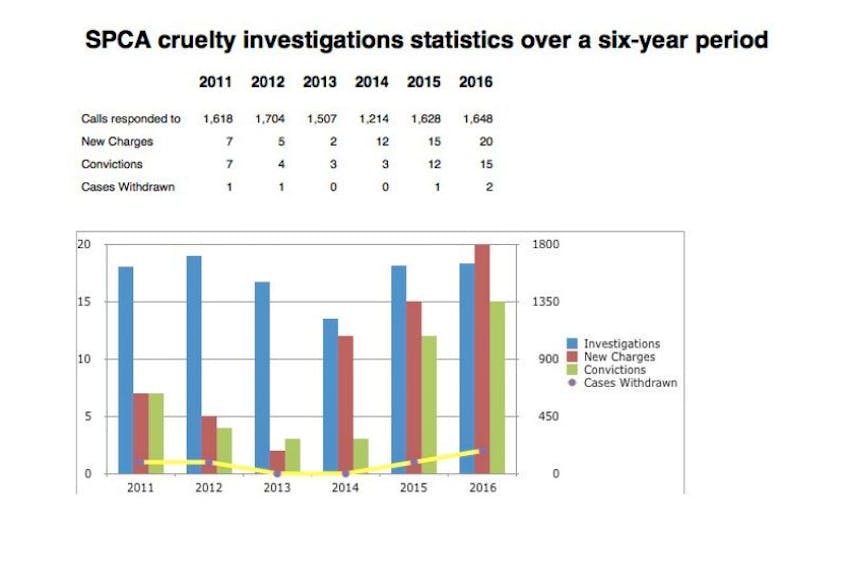The number of cases coming across the desks of newsrooms in the form of press releases also seems to be on rise. This year, there was the case of a pug abused in Kentville on video, a dog euthanized in Windsor after sustaining a broken leg that was left untreated and the abandonment of cats in Annapolis County.
Jo-Anne Landsburg, Nova Scotia SPCA’s chief investigator, said they’ve definitely noticed an increase in charges and convictions.
“The SPCA has a 100 per cent conviction rate of charges that go before the court,” Landsburg said. “We are seeing better sentencing for the charges we are laying including lifetime prohibitions and even a jail sentence under the NS Animal Protection Act.”
Landsburg said they’re also laying criminal code charges for certain cases when evidence permits.
Animal protection officers can lay charges against a person under sections 445 – 447.1 under the Criminal Code of Canada relating to animal cruelty.
The number of animal cruelty officers has increased from three officers in 2011 to 16 in 2017.
Landsburg said the increased staffing has had a significant impact on their response time and the ability to do rechecks in a timely fashion.
“With the increase of charges we are seeing, so is the danger to officers,” she said. “In 2016, our cruelty officers are now wearing body armour vests. This is a direct result of the amount of personal threats and assaults that we’ve received over the years.”
Landsburg said the increased protection was costly for the society, but she says it’s one that could not be ignored.
“Two people were recently charged under the Criminal Code for assault on two of our officers and pled guilty in January 2016,” she said. “Our vehicle was rammed during the same incident in an attempt to prevent the seizure of an animal.”
The SPCA has applied through the Department of Environment for better communication equipment for safety purposes, but are still waiting to hear back.
A recent report by the Animal Legal Defense Fund ranked Nova Scotia as having the second strongest animal protection laws in the county.
Landsburg said she’s been proud of the work done by the animal protection team, but says there’s still more to be accomplished.
“I recently worked with animal rescue groups to compile some suggested regulations for animal rescues in Nova Scotia,” she said. “Together, we brought these ideas to Minister Keith Colwell who was very open to the idea. We’ve also made some small suggestions towards amendments for the new regulations that have been in place since December 2014.”
The number of cases coming across the desks of newsrooms in the form of press releases also seems to be on rise. This year, there was the case of a pug abused in Kentville on video, a dog euthanized in Windsor after sustaining a broken leg that was left untreated and the abandonment of cats in Annapolis County.
Jo-Anne Landsburg, Nova Scotia SPCA’s chief investigator, said they’ve definitely noticed an increase in charges and convictions.
“The SPCA has a 100 per cent conviction rate of charges that go before the court,” Landsburg said. “We are seeing better sentencing for the charges we are laying including lifetime prohibitions and even a jail sentence under the NS Animal Protection Act.”
Landsburg said they’re also laying criminal code charges for certain cases when evidence permits.
Animal protection officers can lay charges against a person under sections 445 – 447.1 under the Criminal Code of Canada relating to animal cruelty.
The number of animal cruelty officers has increased from three officers in 2011 to 16 in 2017.
Landsburg said the increased staffing has had a significant impact on their response time and the ability to do rechecks in a timely fashion.
“With the increase of charges we are seeing, so is the danger to officers,” she said. “In 2016, our cruelty officers are now wearing body armour vests. This is a direct result of the amount of personal threats and assaults that we’ve received over the years.”
Landsburg said the increased protection was costly for the society, but she says it’s one that could not be ignored.
“Two people were recently charged under the Criminal Code for assault on two of our officers and pled guilty in January 2016,” she said. “Our vehicle was rammed during the same incident in an attempt to prevent the seizure of an animal.”
The SPCA has applied through the Department of Environment for better communication equipment for safety purposes, but are still waiting to hear back.
A recent report by the Animal Legal Defense Fund ranked Nova Scotia as having the second strongest animal protection laws in the county.
Landsburg said she’s been proud of the work done by the animal protection team, but says there’s still more to be accomplished.
“I recently worked with animal rescue groups to compile some suggested regulations for animal rescues in Nova Scotia,” she said. “Together, we brought these ideas to Minister Keith Colwell who was very open to the idea. We’ve also made some small suggestions towards amendments for the new regulations that have been in place since December 2014.”









